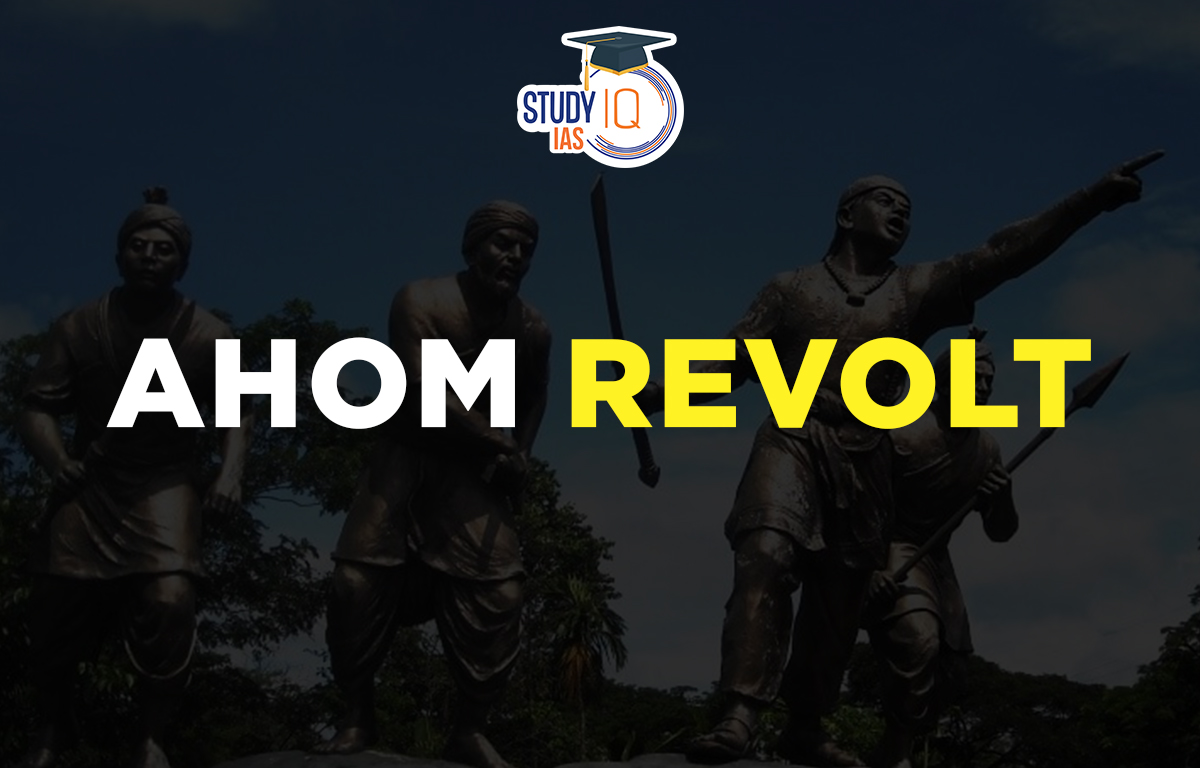Table of Contents
Ahom Revolt
After the First Anglo-Burmese War, the Ahom Revolts out in Assam. The rebellion took place in response to the British Empire annexing territory in 1828. The movement was headed by Gomdhar Konvar. The British soldiers put an end to the uprising. In order to prepare for the UPSC Civil Service Exam, this article will provide you with information on the Ahom Rebellion (1828).
Read More: Paika Rebellion
Ahom Dynasty
During 598 years, from 1228 to 1826, the Ahom dynasty ruled the Ahom kingdom in what is now Assam, India. Sukaphaa or Tsue-Ka-Pha, a Shan prince from Mong Mao who arrived in Assam after traversing the Patkai Mountains, founded the dynasty. The monarchs of this dynasty were referred to as Asam Raja in foreign mediaeval chronicles, but Chaopha or Swargadeo by their subjects.
It acquired a multiethnic character under Suhungmung in the 16th century, having a significant impact on the political and social life of the entire Brahmaputra valley. After the beginning of the Moamoria uprising, the kingdom got weaker, and Assam was frequently assaulted by Burmese troops. With the Burmese invasion of Assam in 1826 and subsequent annexation by the British East India Company under the Treaty of Yandabo, this dynasty’s rule came to an end. After winning the First Anglo-Burmese War and signing the Treaty of Yandabo in 1826, the East India Company took control of the country.
Read More: Anglo-Bhutanese War
Ahom Revolt History
A revolt against British rule over Assam was launched in 1828 by Gomdhar Konwar, a prince of the Ahom royal family, and his friend Dhanjay Borgohain. The process of extending British rule into Assam was completed by the end of 1828. The ruling Ahom monarchs lost both political authority and social rewards when East India Company employees gained political influence.
As new strategies were employed by colonial authorities to strip the aristocracy of its rights and privileges, the feudal structure of the society started to erode. As their enthusiasm for their new friend, who helped them drive the Burmese out of Assam, waned, monarchy advocates organised together to overthrow the British and reinstate the ancient Ahom monarchy.
Read More: Anglo-Afghan War
Ahom Revolt Causes
The British vowed to evacuate Assam after the First Burma War (1824–26). After the battle, the British attempted to subsume the Ahoms’ areas under Company administration rather than emigrate. Ahom prince Gomdhar Konwar and other Ahom citizens including Dhanjay Borgohain and Jairam Khargharia Phukan organised a rebellion in response to this in 1828. At a gathering in Jorhat, the rebels formally crowned Gomdhar Konwar as king.
In October 1828, the rebels assembled in Jorhat and formally installed Gomdhar Konwar. The British fortress at Rangpur was to become the property of the new King. He started enlisting men and gathering arms. He also told his troops to stop paying taxes to the British government. In November 1828, Ahom insurgents started making their way into Rangpur. But when the British heard about it, they surprised the rebels at Mariani.
Some of the rebels gave up, while others managed to flee. In the Naga Hills, Gomdhar and his pals sought safety. Subsequently, he turned himself up, and other people were arrested. They were all found guilty of treason and sentenced to death after being tried in a Panchayat. David Scott, a representative of the British Governor General, lowered his punishment to seven years of exile. Ultimately, the Company decided to take a conciliation route and ceded Upper Assam to Maharaja Purandar Singh Narendra, giving the Assamese king back a section of his kingdom.
After the first Anglo-Burma war was over, the British made a commitment to leave the Ahom areas. Instead, they attempted to subjugate the Ahom territory within the British Empire, which infuriated the Ahom tribe and sparked the Ahom Rebellion of 1828. Gomdhar Konwar, an Ahom prince, staged the Ahom uprising with the help of his fellow citizens Dhanjay Borgohain and Jairam Khargharia Phukan.
Read about: Indigo Revolt
Ahom Revolt Leaders
Gomdhar Konwar, an Ahom prince, led the insurrection against the British and attempted to restore the ancient Ahom kingdom. Dhanjay Borgohain and Jairam Khargharia Phukan are two more significant Ahom Rebellion commanders.
Read about Sanyasi Revolt
Ahom Revolt Outcomes
Gomdhar and his allies sought refuge in the Naga Hills following the collapse of the Ahom Rebellion. Subsequently, he turned himself up, and other people were arrested. They were all found guilty of treason and sentenced to death after being tried by British citizens. The British East India Company, however, commuted his sentence to seven years of exile as a show of good faith.
Subsequently, the British EIC decided to take a compromising stance. Upper Assam was ceded to Maharaja Purandar Singh Narendra. Thus, giving the Assamese king back some of the Ahom kingdom.
Read about: Revolt of 1857
Ahom Revolt UPSC
Following the First Anglo-Burmese War, the Assam region experienced Ahom’s Rebellion. The annexation of territory by the British Empire in 1828 sparked the uprising. The leader of the movement was Gomdhar Konvar. Although Konwar and his soldiers’ attempt to overthrow the British were failed, it led to periodic insurrection occurrences in Assam. Gomdhar Konwar was among the state’s 30 martyrs, and his name was put first in a 1987 publication by the Assam government. Read the complete Ahom Revolt article for UPSC exam preparation.
Read More: Anglo-Nepalese War


 Jallianwala Bagh Massacre, Date, History...
Jallianwala Bagh Massacre, Date, History...
 Important Lakes of India, State wise and...
Important Lakes of India, State wise and...
 Buddhism History, Origin, Sect, Councils...
Buddhism History, Origin, Sect, Councils...





















